
The use of Voice Biometrics in call centres on the rise
According to the ATO, since September 2014 more than 3.5 Million taxpayers (approx 14% of Australia’s population) have enrolled their voiceprints, and are using them, to authenticate themselves when calling the ATO.
The ATO deployed Nuance’s Vocal-Password in August 2014, FreeSpeech in April 2015 and in 2016, they released the voice biometrics technology into their mobile app becoming the first organisation to implement a multi-channel voice biometrics solution.
Deputy commissioner John Dardo said the technology was delivering a better customer experience and swifter resolutions for those seeking assistance.
Nuance’s program reduces each call time by a couple of minutes, which adds up quickly for high-volume call centres such as the ATO.
According to Mr Robert Weideman, Nuances global general manager and executive vice president of enterprise (now that’s a great title if I’ve ever heard one!), if a call centre received five million calls a year it saved an average of $2 million by replacing knowledge-based authentication with voice biometrics.
“Every person’s voice is unique in the same way their fingerprints or irises are unique,” Mr Weideman said. “
Our system can detect patterns outside the frequency of the human ear.
“We can take the voice signal and turn that into a mathematical equation, which is effectively a set of numbers that we store.”
Mr Dardo said the voice recognition programs allowed the agency to implement a “secure, fast and easy way to verify a caller’s identity”.
How Voice Biometrics in call centres works
After a one-time setup process of about one minute, in which the user repeats one sentence three times, authentication for subsequent calls takes about 25 seconds, allowing the customer service agent to dive straight into dealing with an inquiry while the validation software runs in the background.
Whilst Australia is off to a good start, just like the World Cup the Kiwis have got our measure.
Over 1.4 million customers (over 31% of the population) are registered for Voice ID, the highest per-capita enrolment in the world for a voice biometrics system. Revenue Minister Todd McClay says 15,000 hours of phone time are now being saved each year and every customer who calls IRD (Inland Revenue Department) using voice ID saves around 40 seconds per call.
By using Verint’s Voice ID, customers are able to automatically check the balance and payment dates of their Inland Revenue accounts, receive child support information, retrieve their IRD number, activate their online services account and reset passwords, even if they call outside opening hours.
Ady Meretz, Verint’s Asia Pacific president, said that the ability to identify callers on the fly was particularly important given consumers’ have embraced mobile platforms, which he said had moved the power to the consumer.
To find suppliers of Voice Biometrics, AI (Artifical Intelligence), Chatbots and more search our CX Directory.

Be the first to comment